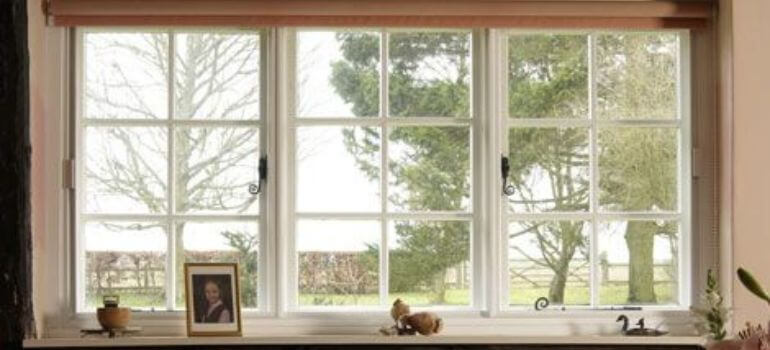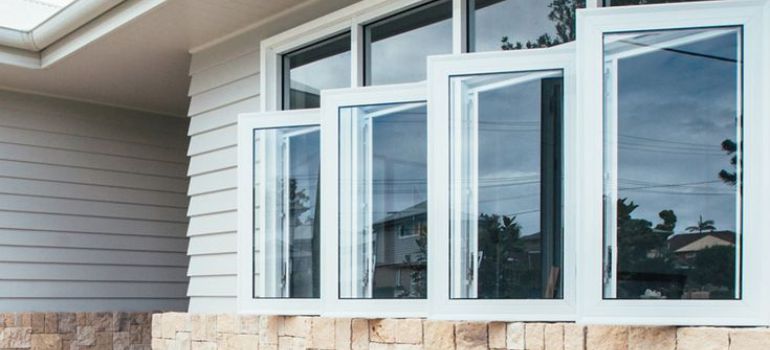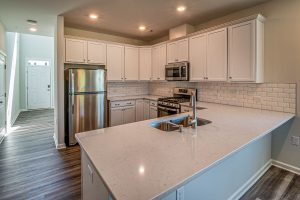Casement windows are hinged on the side and swing outward, whereas double-hung windows have two sashes that move up and down. Choosing between them depends on aesthetic preference, ventilation needs, and ease of cleaning.
Casement windows excel in providing unobstructed views and maximum ventilation, swinging open like a door to catch side breezes. Their design suits contemporary homes well, and their crank handles make them ideal for hard-to-reach areas. Double-hung windows, classic in style, feature an upper and lower sash that slide vertically, a design favored in traditional homes.
They are especially practical for rooms facing walkways, porches, or decks, where an outward-opening window could be obtrusive. Both window styles offer varied options for materials, energy efficiency, and security. Understanding these key differences assists homeowners in making an informed decision that enhances their home’s functionality and aesthetic appeal.
Casement Windows

When exploring the vast world of windows, casement windows stand out for their unique design and functionality. Traditional yet versatile, these windows pivot from side hinges, offering a blend of classic charm and contemporary ease.
Definition
Casement windows are window types featuring one or more hinges at their sides, enabling them to swing open like a door. They can open outward to either the left or the right, depending on their design and the requirements of the space. Typically operated by a crank, they allow for full top-to-bottom ventilation and provide unobstructed views.
Benefits
- Superior Ventilation: The full opening capability allows for optimal air flow, making casement windows ideal for maximizing ventilation in a room.
- Energy Efficiency: When closed, casement windows seal tightly against the frame, offering exceptional energy efficiency by reducing air leakage.
- Unobstructed Views: With their single sash design, these windows offer clear, panoramic views without the division that double hung windows have.
- Enhanced Security: The locking mechanism is embedded within the frame, making it more challenging for intruders to breach.
- Easy Operation: The crank system is straightforward, which makes them very user-friendly, especially in hard-to-reach areas.
Drawbacks
- Mechanical Complexity: The crank system can wear out over time, potentially requiring maintenance.
- Exterior Space Requirements: Casement windows require clearance to swing outward, which can be a constraint in areas such as walkways or patios.
- Limited Size: Their design makes them less suited for very large openings compared to double hung or sliding windows.
- Screen Placement: Screens must be placed on the interior, which may not be aesthetically pleasing for some homeowners.
Double Hung Windows
Double Hung Windows stand out as a traditional fixture in many homes, harmonizing classic aesthetics with modern functionalities. From the charming Victorian residences to contemporary urban dwellings, these windows have proven both versatile and enduring over time.
Definition
Double hung windows feature a unique construction with two operable sashes that can move up and down within the window frame. This design enables the top or bottom sash—or both—to be opened for versatile ventilation options. Unlike their casement counterparts which hinge outward, double hung windows retain their vertical alignment, making them an ideal choice for rooms facing walkways, porches, or patios.
Benefits
- Improved Airflow: The ability to open either sash allows for superior air circulation, contributing to a comfortable indoor environment.
- Easy Maintenance: Many modern designs include sashes that tilt inwards, simplifying the process of cleaning both the interior and exterior surfaces from inside the home.
- Energy Efficiency: When equipped with high-quality glazing and seals, double hung windows can help reduce energy consumption by maintaining indoor temperature.
- Traditional Aesthetic: Their classic appearance often complies with historical neighborhood regulations and adds to the visual appeal of a property.
- Safety: With the option to open just the top sash, these windows provide ventilation while still safeguarding against small children or pets falling out.
- Variety: They come in a vast array of styles, finishes, and materials to complement any home design.
Drawbacks
- Potential for Air Leakage: The more complex mechanics of double hung windows can lead to air escaping, especially over time as weather stripping wears.
- Size Restrictions: Due to their design, there are limits to how wide these windows can be, potentially impacting the amount of natural light.
- Cost: High-quality double hung windows typically come at a premium due to their sophisticated mechanism and energy-efficient features.
Comparison
Choosing the right style of window can significantly enhance your home in terms of aesthetics, energy consumption, and ease of use. When debating between casement windows and double hung windows, understanding their differences can help you make an informed decision. Let’s take a closer look at how these window designs compare across various important aspects.
Energy Efficiency
Energy efficiency is a critical factor for most homeowners, given its impact on heating and cooling costs. Casement windows are known for their superior sealing capabilities, due to the window sash pressing tightly against the frame when closed. This tight seal helps prevent air leaks, offering better insulation.
In contrast, double hung windows can sometimes be less airtight, particularly over time, as the sashes may not seal as tightly against the frame. However, with advancements like double glazing and improved weather stripping, modern double hung windows have significantly bridged the gap in energy efficiency.
Ventilation
Ventilation preferences can dictate the ideal window style for your space. Casement windows, which open outward using a crank, provide top-to-bottom airflow and can be positioned to direct breezes into your home—a significant advantage for maximizing natural ventilation.
On the flip side, double hung windows allow for ventilation either from the top, the bottom, or both, as both sashes can move independently. This flexibility is perfect for those who prefer more controlled ventilation.
Aesthetics
The appearance of your windows plays a substantial role in the overall look of your home. Casement windows offer a sleek and contemporary style, often with fewer muntins, which allows for unobstructed views and ample natural light.
Double hung windows, commonly found in traditional and historical homes, have a classic appeal. Their construction allows for sashes to hold muntins, adding to their characteristic charm. Also, they are available in a wide range of designs and finishes to complement any architectural style.
Maintenance
Maintenance is another practical consideration. Casement windows tend to have fewer parts and are easier to clean from the inside, especially on upper floors, making maintenance somewhat simpler.
In comparison, many double hung windows feature tilt-in sashes which make them relatively easy to clean from the inside as well. While they may have more parts that could require maintenance, modern materials have minimized this concern substantially.
Frequently Asked Questions For Casement Windows Vs Double Hung
Are Casement Windows Better Than Double-hung Windows?
Casement windows offer superior ventilation and sealing capabilities compared to double-hung windows, making them a popular choice for energy efficiency and ease of use.
What Is The Main Drawback To The Use Of A Casement Window?
The main drawback of casement windows is their potential for wind damage when fully extended.
What Costs More Casement Or Double Hung?
Casement windows typically cost more than double-hung windows due to their higher energy efficiency and security features. Prices can vary based on materials and size.
Why Are Casement Windows More Expensive?
Casement windows typically cost more due to their complex design, superior sealing capabilities, and the higher-quality hardware used for operation and security. They also often offer better energy efficiency, which can influence the price.
Conclusion
Deciding between casement windows and double hung styles hinges on personal preference and your home’s architectural needs. Both offer distinct advantages, from airflow to aesthetic appeal. As you weigh your options, consider maintenance, ventilation, and design to ensure your choice enhances your living space for years to come.



